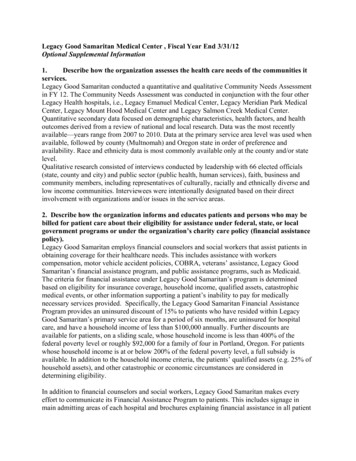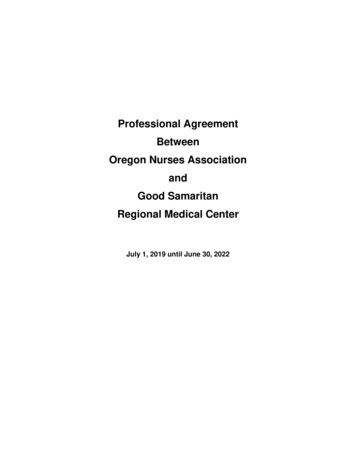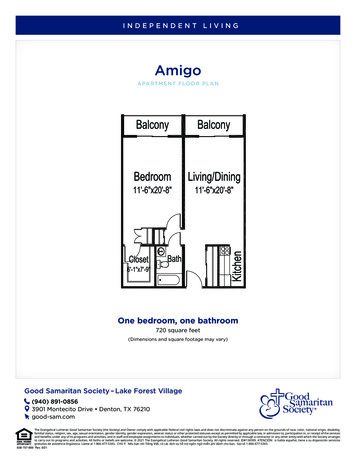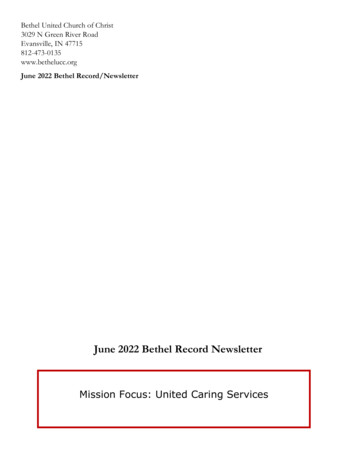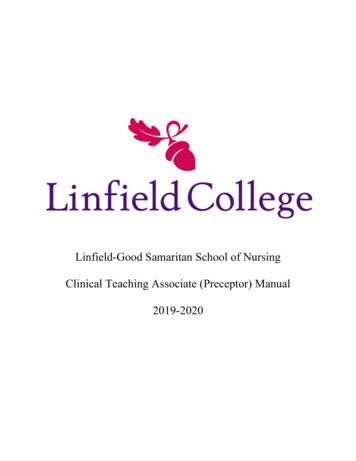
Transcription
Linfield-Good Samaritan School of NursingClinical Teaching Associate (Preceptor) Manual2019-2020
Table of ContentsChapter I: Roles, Responsibilities, and Selection of the Clinical Teaching Associate(Preceptor)Student/Clinical Teaching Associate (Preceptor’s) Working Relationship . 1Clinical Teaching Associate (Preceptor), Student, and Faculty Roles and Responsibilities . 2Clinical Teaching Associate (Preceptor) Selection Process . 4Clinical Teaching Associate (Preceptor) Selection Criteria . 5Chapter II: Curriculum: Overview and OutcomesOverview of the Linfield-Good Samaritan School of Nursing Program . 7Linfield-Good Samaritan School of Nursing Program Outcomes . 8Linfield-Good Samaritan School of Nursing Theoretical Model for Community-BasedNursing Education . 9Linfield-Good Samaritan School of Nursing Curricular Themes, Modes of Inquiry,and Curriculum Conceptual Organization . 10Linfield-Good Samaritan School of Nursing Student Technical Skills Preparation . 11Chapter III: Teaching ResourcesEffective Mentoring in the Clinical Setting . 15Linfield-Good Samaritan School of Nursing Clinical Reasoning Model . 21Linfield-Good Samaritan School of Nursing Clinical Reasoning Model DefinitionAnd Terms . 22Novice to Expert Competency Framework. 26Student Readiness for Increased Clinical Responsibilities . 27Constructive Feedback . 29Conflict Resolution . 30i
Chapter I: Roles, Responsibilities, and Selection of theClinical Teaching Associate (Preceptor)As partners in clinical education, both Clinical Teaching Associates (preceptors) and faculty areinstrumental in facilitating the professional development of students. Preceptorships are valuablein preparing students for clinical practice. Positive outcomes for students include enhancedsocialization into the nursing profession, refinement of critical thinking ability and interpersonalcommunication skills in practice, improved clinical skill and knowledge development, increasedself-confidence, and reduced anxiety and stress during clinical experiences.Student/Clinical Teaching Associate (Preceptor’s) Working Relationship The student is not working under the Clinical Teaching Associate’s (Preceptor’s) license.No one works on another’s license. Students have the right by law to practice as a part of the learning process. The standardof care must be the same as that rendered by a registered nurse. Everyone has the right toexpect competent nursing care, even if rendered by a student as part of clinical training.The standard is measured against conduct of other reasonably prudent RN’s with similarknowledge and experience under the same circumstances. The Clinical Teaching Associate (Preceptor) has the responsibility to delegate accordingto the subordinate’s abilities and to supply adequate supervision. A Clinical Teaching Associate (Preceptor) could be seen as negligent for ignoring thatthe student is not competent, and not supervising a procedure if the student isinexperienced or requires close supervision in carrying out a function. The student is liable for carrying out a function beyond his/her capabilities, or for notrefusing to perform the function without supervision.Clinical Teaching Associate(Preceptor) Manual12019-2020 Edition
Clinical Teaching Associate (Preceptor), Student, and Faculty Roles andResponsibilitiesClinical Teaching Associate (Preceptor)1. Meets with the student and clinical faculty prior to beginning of clinical hours.2. Coordinates the student’s orientation to the facility, including staff roles and client expectations.3. Ensures the student is identified as a student while in the clinical area and is not regarded as staff forthe clinical site.4. Fosters the student’s integration into the workplace culture and the health care team by involving thestudent in meetings related to client care and other appropriate professional matters.5. Provides faculty and the student with a copy of the Clinical Teaching Associate’ s (Preceptor’s) workschedule to assist in scheduling the student’s clinical days.6. Arranges for a substitute Clinical Teaching Associate (Preceptor) when absent.7. Facilitates learner centered education through collaborative identification of the student’s learningneeds, open communication, informing the student about learning resources, and mutual assessmentof the student’s learning outcomes.8. Serves as a role model for the student, demonstrating professional values and behaviors such ascaring, integrity, effective interpersonal communication, critical thinking, and conflict management.9. Provides appropriate support and encouragement to assist the student to cope with stress and reduceanxiety associated with clinical practice.10. Assists the student in learning the process of prioritization that ensures safe and effective nursingcare.11. Discusses, facilitates and supervises student learning activities and outcomes.12. Monitors the student’s provision of nursing care to ensure client safety, and provides a safe learningenvironment for the student.13. Recommends appropriate clients for the student to provide nursing care, and assists with accessingagency information.14. Provides instruction to the student concerning the realities of the professional world of nursingpractice.15. Stimulates development of the student’s clinical judgment and critical thinking ability throughreflective practice and the application of evidence based practice.16. Provides regular constructive feedback to the student regarding progress toward meeting clinicaloutcomes.17. Collaborates with faculty to determine the student’s readiness to perform skills independently.18. Consults with faculty regularly regarding the student’s progress toward meeting the clinicaloutcomes, including suggestions, problems, and concerns.19. Completes a written clinical performance evaluation of the student assessing the attainment of clinicaloutcomes (as requested).Clinical Teaching Associate(Preceptor) Manual22019-2020 Edition
tes with the Clinical Teaching Associate (Preceptor) and faculty to scheduleclinical days.Participates in orientation per agency policy/ Clinical Teaching Associate (Preceptor)instructions, and complies with agency policies, standards, procedures, rules andregulations.Notifies Clinical Teaching Associate (Preceptor) and faculty of absences per coursesyllabus and negotiates makeup hours.Provides written learning outcomes to the Clinical Teaching Associate (Preceptor) andfaculty, and discusses strategies for meeting clinical outcomes.Demonstrates motivation, initiative, and a willingness to learn in the clinical setting.Assumes responsibility for learning by asking pertinent questions and being prepared forclinical experiences.Demonstrates stewardship by acting with integrity in an accountable and responsible wayto ensure professional nursing care is provided to clients.Keeps faculty informed about clinical experiences, including any concerns regarding thestudent’s role, client or student safety, or standards of conduct, performance and ethics.Requests appropriate assistance when doing a new skill or if uncertain about how toperform a skill.Only provides nursing care to the level taught and determined competent by the ClinicalTeaching Associate (Preceptor) and faculty.When administering medications, the student reviews information about the drugs andknows the contraindications, actions, interactions, side effects, and age specificconsiderations of the drugs. The student knows why the clients are receiving themedications, and performs any indicated assessment. In addition, the student onlyadministers medication they have drawn up or retrieved from a med cart.Assesses own progress toward meeting clinical outcomes, and communicates learningneeds to faculty and the Clinical Teaching Associate (Preceptor).Is open to constructive criticism from faculty and the Clinical Teaching Associate(Preceptor), and uses feedback to improve nursing practice.Meets clinical outcomes as stated in the course syllabus.Completes a written clinical performance self-evaluation assessing the attainment ofclinical outcomes.Faculty1.2.3.Notifies the student of the Clinical Teaching Associate’s (Preceptor’s) name and phonenumber, and facilitates scheduling of the student’s clinical days.Orients the student to the course, including clinical outcomes and requirements of thecourse, as well as role expectations of the student, faculty, and the Clinical TeachingAssociate (Preceptor).Meets with the Clinical Teaching Associate (Preceptor) and student prior to studentbeginning clinical hours.Clinical Teaching Associate(Preceptor) Manual32019-2020 Edition
4.5.6.7.8.9.10.11.12.13.Orients the Clinical Teaching Associate (Preceptor) to the nursing curriculum; the course,including clinical outcomes, requirements of the course, and evaluation methods; and roleexpectations of the Clinical Teaching Associate (Preceptor), faculty and the student.Ensures the student has completed the School of Nursing Health Passport requirementsand additional clinical site requirements.Complies with agency policies, standards, procedures, rules and regulations.If the student is employed by the clinical agency, faculty coaches the student about thedifferences between the student’s role as employee and as student. Faculty ensures thatthe student wears the student name badge. The Clinical Teaching Associate (Preceptor)must not have any line of authority to the student related to the student’s employment.Communicates weekly with the student on an individual basis or in group praxis seminarsto monitor progress toward meeting clinical outcomes.Demonstrates commitment to the partnership between faculty and the Clinical TeachingAssociate (Preceptor) in facilitating the student’s application of theoretical knowledge topractice and socialization into nursing practice.Maintains ongoing communication with the Clinical Teaching Associate (Preceptor) inthe clinical area or by telephone/email contact for information about student progress inmeeting clinical outcomes, and provide guidance to the Clinical Teaching Associate(Preceptor) with regard to teaching and evaluating the student.Provides constructive feedback to Clinical Teaching Associate (Preceptor) to facilitatedevelopment of the Clinical Teaching Associate’s (Preceptor’s) teaching and evaluationskills with students.Available by telephone/email to the student and the Clinical Teaching Associate(Preceptor) for problem solving or other relevant matters during all clinical hours.Assists the student and the Clinical Teaching Associate (Preceptor) with the evaluationprocess, and is responsible for the final clinical evaluation of the student.Clinical Teaching Associate (Preceptor) Selection ProcessIn the NURS 475 Integrated Experiential Learning IV course, where a preceptorship clinicalteaching model is used, Clinical Teaching Associates (Preceptors) will be selected according tothe school's Clinical Teaching Associate (Preceptor) Selection Criteria.PurposeTo provide guidelines for coordinating the Clinical Teaching Associate (Preceptor) partnershipwith the supervising faculty in teaching and evaluating students.Definition of a Clinical Teaching AssociateA Clinical Teaching Associate (Preceptor) is a registered nurse who has undergone specificeducation/training to serve as a role model, resource and coach for nursing students. TheClinical Teaching Associate (Preceptor) functions under the direction of the nurse educator ornurse educator associate (adjunct faculty). (From Oregon State Board of Nursing, OregonAdministrative Rules, Division 21 Standards for the Approval of Education Programs in NursingPreparing Candidates for Licensure as Practical or Registered Nurses, 851-021-0005.)Clinical Teaching Associate(Preceptor) Manual42019-2020 Edition
The NURS 475 Integrated Experiential Learning IV course, which requires the use of ClinicalTeaching Associates (Preceptors) will follow procedures developed by faculty:1.The Nurse Manager/Designee of the unit/agency will recommend appropriate ClinicalTeaching Associates (Preceptors) for students placed in that unit/agency based on theClinical Teaching Associate (Preceptor) selection criteria.2.The supervising faculty will discuss with the Clinical Teaching Associate (Preceptor) theClinical Teaching Associate (Preceptor) selection criteria and the roles of the ClinicalTeaching Associate (Preceptor), student and supervising faculty.3.The supervising faculty will return the signed Clinical Teaching Associate (Preceptor)Selection Criteria form in the Clinical Teaching Associate (Preceptor) Manual to thedesignated administrator within two weeks of the initiation of clinicals. The form will beincluded in the school’s Clinical Teaching Associate (Preceptor) data-base.4.The Integrated Experiential Learning Coordinator or designee will provide a copy of thecourse syllabus and the Linfield-Good Samaritan School of Nursing Clinical TeachingAssociate (Preceptor) Manual to the Clinical Teaching Associate (Preceptor).Clinical Teaching Associate (Preceptor) Selection CriteriaApproved: 08/25/03; Last Revised: 11/12/12Clinical Teaching Associate (Preceptor) selection will be based on the recommendation of the NurseManager/Designee regarding professionalism and organizational/leadership skills based on competencieslisted below:1.2.3.4.5.6.7.8.9.10.11.12.Current unencumbered registered nurse license in the state where the clinical agency is located.Has the equivalent of at least two years of full-time experience as a registered nurse.Bachelor’s Degree in Nursing preferred.Demonstrates knowledge and expertise in providing nursing care to diverse populations,implementing standards of conduct, performance and ethics.Demonstrates effective communication skills in written and verbal forms, and is comfortabledelivering constructive feedback.Demonstrates an interest in sharing knowledge with students and staff through role modeling andteaching. Is proficient in clinical teaching, and provides support without rescuing, finds the"teachable moment," and believes in the individual's potential.Demonstrates effective interpersonal skills and aids in the professional socialization of others.Demonstrates strong organizational skills and ability to prioritize patient care.Demonstrates commitment to own professional development and to the role of preceptor.Demonstrates knowledge of leadership principles such as coaching, reinforcing and encouraginginitiative.Demonstrates knowledge of the use of evidence based practice in the clinical area.Demonstrates sensitivity to individuals and teams, and skill in conflict resolution. Perceives andis aware of needs, feelings and concerns of others and reacts appropriately.Clinical Teaching Associate(Preceptor) Manual52019-2020 Edition
AgencyAcademic YearClinical Teaching Associate (Preceptor)SignatureFaculty SignaturePrint NamePrint NameHighest Nursing Degree EarnedNumber of Years in Clinical PracticeDateDateUnitCourseClinical Teaching Associate(Preceptor) Manual62019-2020 Edition
Chapter II: Curriculum: Overview and OutcomesOverview of the Linfield-Good Samaritan School of Nursing ProgramThe School of Nursing provides a quality education derived from a liberal arts foundation andnursing theory and research, supplemented by content from other disciplines. The Schoolprepares graduates to act as providers of care, designers/managers/coordinators of care andmembers of the nursing profession to meet the health needs of multidimensional individuals andfamilies, groups and communities in a diverse and multicultural society. Analytical, critical, andcreative thinking, as well as intuitive processes are developed as a basis for independent andcollaborative decision making in the application of clinical judgment, which includes the nursingprocess. The curriculum is designed to expose the student to a variety of factors that contributeto the development of a professional worldview. Among these factors are an awareness of thehistorical and legal context of nursing, diverse professional and cultural values, social issues, andethical concepts. Experiences are selected to motivate students toward understanding the needsof others, making creative and constructive contributions to society, and lifelong learning.The nursing program uses the following professional nursing standards and guidelines: AACN The Essentials of Baccalaureate Education for Professional Nursing Practice,which can be found at the following Web m.ANA Code of Ethics for Nurses with Interpretive Statements that describes the ethicalobligations and duties of professional nurses and nursing students. It can be found at thefollowing Web site: http://nursingworld.org/codeofethicsANA Standards of PracticeOSBN Nurse Practice ActFurther information about the Linfield-Good Samaritan Curriculum can be found ing/nursing-curriculum/Clinical Teaching Associate(Preceptor) Manual72019-2020 Edition
Linfield-Good Samaritan School of Nursing Program OutcomesApproved 5/16/16Program Outcome 1: Integrates knowledge from liberal arts, sciences and nursing science as abasis for professional practice.Program Outcome 2: Applies clinical reasoning, reflective practice and evidence-based practicein the provision of safe, quality holistic client-centered care.Program Outcome 3: Communicates effectively and collaboratively in a professional practice.Program Outcome 4: Uses information and technology to communicate, manage knowledge,mitigate error, and support decision making to achieve health care outcomes for clients.Program Outcome 5: Provides effective nursing care that considers diverse values, cultures,perspectives and health practices.Program Outcome 6: Demonstrates accountability for the delivery of standards-based nursingcare that is consistent with moral, altruistic, legal, ethical, regulatory, humanistic and socialjustice principles.Program Outcome 7: Uses principles of stewardship and leadership effectively and efficiently toinfluence the practice environment and improve health outcomes.Program Outcome 8: Demonstrates awareness of and responsiveness to the larger context of thehealth care system, and effectively calls on system resources to provide care that is of optimalquality and value.Program Outcome 9: Demonstrates commitment to the nursing profession through thecomportment of professional values and standards.Clinical Teaching Associate(Preceptor) Manual82019-2020 Edition
Linfield-Good Samaritan School of Nursing Theoretical Model forCommunity-Based Nursing EducationThe Linfield-Good Samaritan School of Nursing Theoretical Model for Community-BasedNursing Education provides a visual organizational structure for the curriculum. The modelreflects the dynamic relationship between global and local communities and the community oflearning. Central to this community of learning is a focus on learner centered education, whichengages students in the practice of health promotion, illness prevention and treatment andreflects the value of social justice. The curriculum is grounded in a liberal arts education thatincludes integrative learning, inclusive excellence, and experiential learning. The curricularthemes of communication, community, diversity, ethics, health, and stewardship provide afoundation for the program’s design and are developed throughout the program. Professionaleducation includes nursing knowledge (what the student needs to know), clinical skills (what thestudent needs to do) and socialization into nursing practice (the student’s “being” as aprofessional nurse). The ways in which the student engages in a process of inquiry includeevidence based practice, praxis, and reflective practice.Clinical Teaching Associate(Preceptor) Manual92019-2020 Edition
Linfield-Good Samaritan School of Nursing Curricular Themes, Modes ofInquiry, and Curriculum Conceptual OrganizationCurricular StewardshipModes of Inquiry:Evidence Based PracticeReflective PracticePraxisCurriculum Conceptual Organization:Each semester is organized around a central theme:Semester 1: Foundations for Community-Based Nursing Practice Foundations Professional Communication Evidence Based Nursing Integrated ClinicalSemester 2: Chronic Health Chronic Conditions, Lifespan Pathophysiology & Pharmacology Mental health & Illness, Lifespan Integrated ClinicalSemester 3: Acute Health Acute Conditions, Lifespan Transitions in Health & Illness Integrated ClinicalSemester 4: Stewardship of Health Population Based Nursing Nursing Leadership Integrated ClinicalClinical Teaching Associate(Preceptor) Manual102019-2020 Edition
Linfield-Good Samaritan School of Nursing Student Technical SkillsPreparationEffective Date: Spring 2017The following is a list of skills and critical thinking simulations students learn in the experientiallearning lab or clinical at various levels of the curriculum. Some of these simulations and skillsare tested for competency in performance with a manikin or live actor. Some of the skills are forlearning and practice only without testing. Experience level with students’ ability to performthese critical thinking or psychomotor skills varies widely among our students. Please clarify thecomfort level with individual students and involve faculty as needed to assist students withperforming skills on clients.1st Semester skills: Medical asepsis/Infection controlo Hand washingo Universal precautionso Personal Protective Equipment/Isolation Electronic health records/Documentation (Graded) Mobilityo Range of Motiono Positioningo Transferso Use of mobility devices/Gait belto Fall Risk assessment Hygieneo Bed-bathso Peri-care (demo in lab, practice in clinical)o Changing an occupied bed Vital Signs and Pain assessment (Graded simulation) Abbreviated Head-Toe assessments (Graded simulation) Oxygen delivery devices Incentive spirometry Medication administration and pharmacokinetics (Graded simulation)o Oral, topical, ophthalmic, otic, inhalation, nasal, rectalo Injections: intramuscular, subcutaneous, intradermal, z-tracko Blood glucose monitoring and insulin administration Sterile technique: (Graded Simulation)o Establishing and maintaining a sterile fieldo Urinary catheterization – straight and indwelling (sterile procedure) Communicationo SBARR reportso Telephone orders Wound Assessment (8 wounds) and Dressing Changes (clean)Clinical Teaching Associate(Preceptor) Manual112019-2020 Edition
Simulations: High Impact Learning Simulationso Teaching a patient one of the following: MDI, IS, nebulizer treatment to child,peak flow metero Patient with asthma that is wheezing: respiratory focused assessmento Patient with pneumonia: focused respiratory assessmento Patient with increasing respiratory distress and use of oxygeno Patient EOL to give compassion careo Therapeutic Communication: getting consent form for surgery signed but theclient is confusedo Therapeutic Communication: EOL spiritual and cultural careo Four patients with different medication errorso Patient with DVT: wound assessmento Patient with Right sided abdominal pain: Assessmento Patient with COPD who is breathless: respiratory assessment and use of oxygenOnline Medication Dosage Calculation Program (Graded)Online Shadow Health Assessment and Focused Assessment Simulations with 6 differentclients across the lifespan. (Graded)2nd Semester skills: Mental health assessment (MHA)(Graded) Medicationso NG placemento Enteral feeding and medication administrationo Medication reconciliation (Graded)o Medication simulation: medication errors (Graded) Oxygen managemento Peak flow (learned in chronic illness NUR 355)o Tracheostomy suctioning and care (sterile procedure) Simulations:o Asthmao Home health chronic conditiono Clinic UTI: straight catho Trach suctioning reviewo Medication reconciliationo Conducting a mental status exam (live actor simulations and clinical) (Graded)o Communicating with a client who is experiencing mania (live actor simulations)(Graded)o Communicating with a client who is at high risk for suicide (live actorsimulations) (Graded)o Communicating with a client experiencing hallucinations (live actor simulations)(Graded)Clinical Teaching Associate(Preceptor) Manual122019-2020 Edition
3rd Semester skills: IV Starts IV management (Graded)o Volume infusion: priming and timingo IV piggy-back medication administration§ Exemplar used in skills performance sign-off: Clindamycino IV push medication administration§ Exemplar used in skills performance sign-off: Morphine§ Carpuject and diluted drug administration taught (faculty consensus hasbeen that carpuject education is not necessary for Spring and onward)o IV site assessment Fluid Drainage Systemso Overview of the following drainage systems: Jackson-Pratt, Penrose, nasogastrictubes, hemovac, ostomies, mic-key g-tubes, suprapubic urostomies, wall suction§ Faculty consensus that more focused education with regard to nursingmanagement of these fluid drainage systems is warranted in Spring. Intrapartum assessmento Electronic fetal heart monitoring Postpartum assessment (Graded) Newborn assessment (Graded) Pediatric assessment (Graded)o Pediatric weight-based dosage calculationso Mandatory reporting laws for child abuse and neglect Orientation to code/resuscitation cart TBSA estimation and fluid resuscitation calculations in acute burn management Introduction to ESI triage EKG rhythm strip analysis Decision-making and management of high-flow and low-flow oxygen delivery devices Simulationso Focused Acute Assessments (neuro, CV, resp, abd, post-op)o IV fluid managemento Foley catheter placemento Sterile UA collectiono Infection Control, PPE: meningitis, GBS , sepsiso Newborn Thermoregulationo Electronic Fetal Monitoring (EFM)o Gestational Diabeteso Postpartum Hemorrhageo Preeclampsia management – Eclampsia with seizureo Acute Myocardial Infarctiono Hyper/Hypoglycemia management in adult, ped, and newborn scenarioso Pain assessment and managemento Chest Tube management; acute tension pneumothoraxo Management of blood product administration; transfusion reactionClinical Teaching Associate(Preceptor) Manual132019-2020 Edition
oooooooDNR advocacyPediatric abuse scenario, patient advocacyEnd of life care – lung cancer, failure to thrive, infectionMedication administration, documentation, educationPrioritization, Critical thinking/problem solvingUtilization of the Rapid Response Team (RRT)Therapeutic communication, communication with PCP4th Semester skills: Simulations:o Simulation #1ü Prioritizationü Time managemento Simulation #2ü Interdisciplinary Team ConferenceClinical Teaching Associate(Preceptor) Manual142019-2020 Edition
Chapter III: Teaching ResourcesEffective Mentoring in the Clinical SettingThis article is one in a series on the roles of adjunct clinical faculty and preceptors, who teach nursing students and newgraduates to apply knowledge in clinical settings. This article describes mentoring strategies clinical instructors and preceptorscan use to help ease novice nurses’ transition to practice.The nursing profession continues to undergorapid transformation as changes associated withhealth care reform, the expansion of health caretechnology, and a shift in the U.S. population takeeffect. Strategies to improve quality, ensurepatient safety, lower costs, and increase access tocare place growing demands on nurses and otherhealth care providers.1, 2students and use this time as an opportunity formentoring. Mentoring can be defined as areciprocal relationship between two or morepeople (one experienced and one novice) thatinvolves counseling, guiding, sharing knowledge,providing support, and role modeling. Clinicalmentoring has been shown to improve selfconfidence, maximize learning, enhancesatisfaction, and promote professional growth.3Mentoring should be a deliberate and intentionalactivity, regardless of whether it occursinformally or as part of a structured mentoringprogram.Nursing students and new graduates facechallenges in understanding these issues, andmany struggle to enter the work environmentready for practice. For this reason, clinicalteachers and nurse preceptors play a vital role inhelping to prepare novices for the demands theywill face as they assume nursing roles. It’sessential that those working with students usestrategies that may help ease novice nurses’transition to practice and provide them withneeded skills, helping to ensure they are ready fortheir professional roles.When and how mentoring occurs can be affectedby the various roles and responsibilities of theclinical teacher and preceptor. These may involveevaluating performance, assigning a letter grade,or developin
Linfield-Good Samaritan School of Nursing Clinical Teaching Associate (Preceptor) Manual 2019-2020
